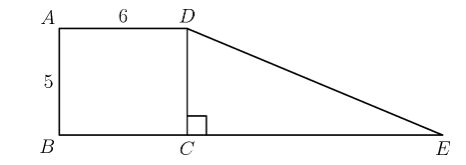A quadrilateral with at least one pair of parallel sides is called a trapezium. Area of a trapezium is half of the product of sum of the parallel sides and height. Let's find its area as the sum of the area of a rectangle and a triangle.
Rectangle (ABCD) and right triangle (\triangle DCE) have the same area. They are joined to form a trapezoid, as shown. What is (DE)?
((A)12\qquad(B)13\qquad(C)14\qquad(D)15\qquad(E)16)

American Mathematical Contest 2014, AMC 8 Problem 14
Area of Trapezium
3 out of 10
Challenges and Thrills in Pre College Mathematics
Excursion Of Mathematics

Area of the triangle (\triangle DCE) = \frac{DC.CE}{2}
And the area of the square = (AB.AD)
It is given that (AB=5)
Then clearly (AB=DC=5)
(\frac{5.CE}{2}=30) , (30 is the area of the square)
This gives the value of (CE)
Now applying Pythagorean theorem in (\triangle ACE)
(DE^{2}=CE^{2}+DC^{2})
Which gives (DE=13)